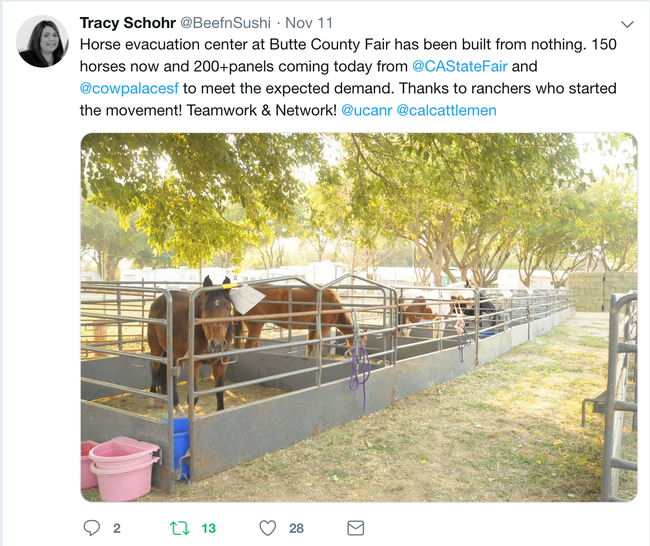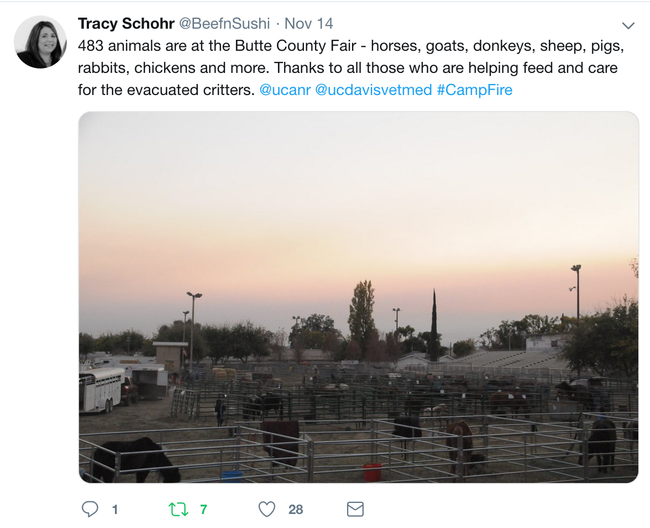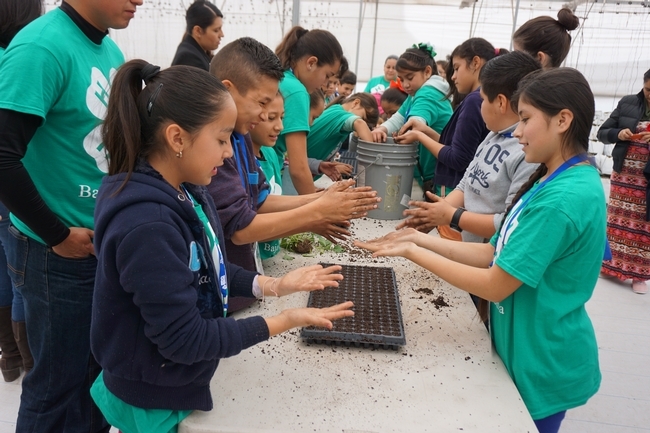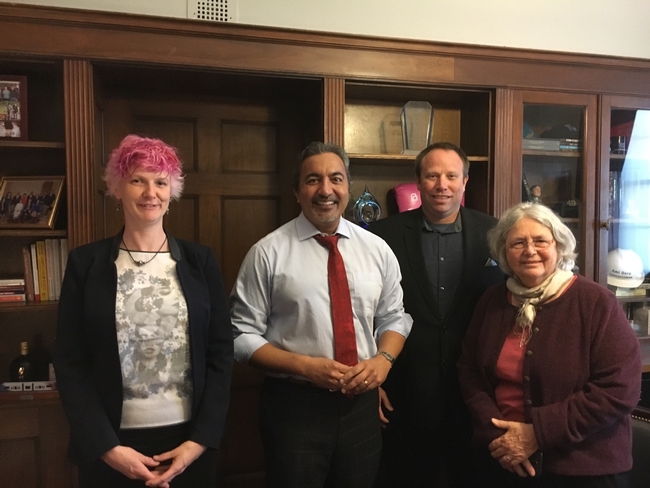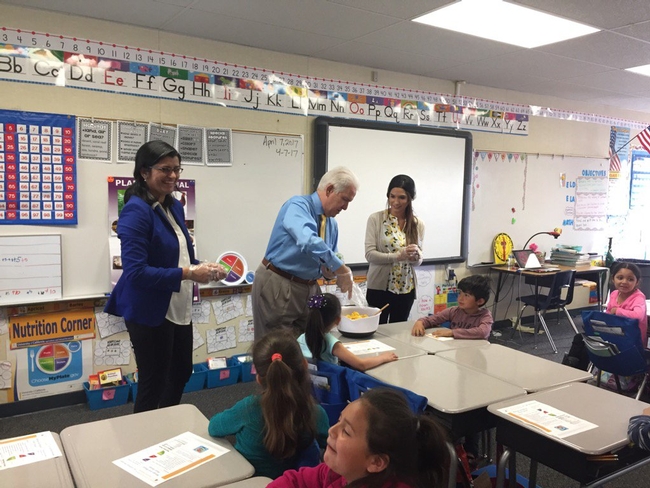Posts Tagged: Emily Symmes
Delivering hope in the midst of loss
Between the Camp Fire in Butte County and the Woolsey Fire in Southern California in November, most ANR members have been affected in some way by the devastating wildfires. Several have experienced major personal losses that they are still dealing with.
While the Camp Fire was still raging on Nov. 14, Emily Symmes, director of UCCE in Butte County, wrote:
“As you can imagine, due to the destruction of nearly the entire town of Paradise and other ridge communities, all of our employees have numerous friends, family, and loved ones who have lost their homes and all of their belongings, as evacuations were so sudden and urgent that most left with only what they could grab in minutes. As such, all have been affected to varying degrees. We have two direct staff members, Alexandra Falk (nutrition education specialist) and John Klepps (Honey Bee Tech Transfer Team) who lived in Paradise. Both have received confirmation that their homes were among those destroyed. They and their families and pets are now safe and have found temporary housing. Many in our extended network of 4-H and Master Gardener program participants and volunteers resided in Paradise have also been heavily impacted, losing everything.”
Among the Master Gardener volunteers in Paradise who lost their houses is Bob DiPietro and his wife, parents of Damon DiPetro of ANR's IT team. Damon's sister and her family also lost their house.
Colleagues have asked how to help.
Emergency resources for UC employees
In response to queries, the Staff Assembly has posted information on their website about the impact of the Camp Fire on our ANR employees and their families at http://staffassembly.ucanr.edu/Resources_/Emergency_Resources_/. Earlier in the year, they posted similar information for those impacted by the Mendocino fires and have committed to maintain Emergency Services information on their website whenever any UC ANR employees are impacted.
Emergency support is also available to UC employees from the university's benefit plans https://ucnet.universityofcalifornia.edu/news/2018/11/emergency-support-from-ucs-benefit-plans.html.
UC ANR assists Camp Fire survivors
In the midst of their own losses, UCCE staff in Butte County and neighboring counties have been reaching out to assist community members. For example, Ryan Cleland, 4-H representative, has been working with the 4-H community since Nov. 8, the day the Camp Fire erupted, to coordinate assistance and volunteerism. He is providing vetted and frequently updated information on where evacuated and displaced people can find help and how other community members can volunteer, donate and contribute.
The UCCE nutrition education team has been assisting with meal preparation at shelters, and also with volunteering at indoor youth activities available through the shelters and the local area recreation district.
Other UCCE staff and advisors have been volunteering where needed – helping gather and deliver supplies, volunteering at human shelters and animal shelters, helping out at the numerous meal centers that have popped up.
UC Master Gardener volunteers have been reaching out to fellow Master Gardeners who have lost their homes or remain evacuated to offer housing and other support.
Tracy Schohr, UCCE livestock and natural resource advisor in Plumas and Sierra counties, has been helping care for large animals in the evacuation zone.
The forestry, fire and natural resource advisors have ongoing fire safety research and education programs, coordinating with fire safe councils, and working with other agencies to assist in recovery and become better prepared for natural disasters.
AVP Powers announces 51 proposals invited for competitive and high-reward grants
AVP Wendy Powers announced the letters of intent (LOIs) for which principal investigators have been invited to submit full proposals to ANR's Competitive Grants Program and High-Risk/High-Reward Grants Program. The list of 51 approved projects can be found at http://ucanr.edu/sites/anrstaff/files/261626.pdf.
This year ANR received a total of 108 letters of intent — 97 for the Competitive Grants Program and 11 for the High-Risk/High-Reward Grants Program. Strategic Initiative leaders and their respective panels reviewed all letters of intent thoroughly to address the appropriateness of the proposals in addressing the goals and criteria outlined by each funding opportunity.
ANR Competitive Grants Program
The purpose of the ANR competitive grants program is to address high-priority issue areas identified by at least one of the strategic initiatives: Endemic and Invasive Pests and Diseases (EIPD), Healthy Families and Communities (HFC), Sustainable Food Systems (SFS), Sustainable Natural Ecosystems (SNE), and Water Quality, Quantity and Security (Water).
ANR Competitive Grants Program 2017 Cycle:
- Full proposals due June 19
- Technical peer review: mid-June – early September 2017
- Strategic Initiative review and recommendations: end of September 2017
- Program Council review and recommendations: October/November 2017
- Announcement of funded grants: November/December 2017
High-Risk/High-Reward Grants Program
Given the complexity of societal problems, high-risk research is necessary to achieve gains for real progress in addressing present and emerging challenges. This program will provide funds to initiate and complete research and proof-of-concept efforts that serve as the basis for larger funding opportunities. These projects must be of a high-risk/high-reward nature that are best conducted in a controlled, research setting and, if successful, lend themselves to subsequent larger funding opportunities and/or intellectual property development.
Proposed projects must be within the scope of the ANR Strategic Vision. All ANR academics with PI status are eligible to apply. Proposals will be accepted using the same timeline as outlined for the traditional competitive grants program, but reviewed separately due to the nature of the proposal.
For questions about ANR's competitive grants program or high-risk/high-reward grants program, please contact Melanie Caruso at mmcaruso@ucanr.edu.
Nutrition Policy Institute launches Research to Action news brief
The Nutrition Policy Institute has launched a news brief called Research to Action. The publication will provide information on research, policy, news, announcements, events, articles and action items focused on nutrition and healthy communities.
The first issue looks at the work of the National Drinking Water Alliance (NDWA). NPI is the “hub” for NDWA, which engages in and coordinates evidence-based efforts going on all over the country to improve tap water safety and access, especially for children, and to provide drinking water education and promotion. The NDWA website is a “go-to” resource for information on drinking water.
Future editions of Research to Action will be sent several times per year. Please sign up for the Research to Action mailing list, and please share Research to Action with colleagues who would be interested in receiving it.
4-H calls alumni and friends to join its new network
If 4-H has touched your life, raise your hand. Visit http://4-H.org/raiseyourhand to voice your support for the California 4-H youth development program, help it win a national competition and connect with a network of 4-H alumni and friends.
You are considered alumni if you were in a 4-H Club, took part in a 4-H after-school program, served as a volunteer leader or taught a project. Friends of 4-H are also invited to raise their hands.
“Having experienced our programs first-hand, our alumni know about the positive impact of 4-H,” said Glenda Humiston, vice president of UC Agriculture and Natural Resources and a 4-H alumna.
As part of the new 4-H network being built in the 4-H Raise Your Hand campaign, members will get news about 4-H programs in California and stay in touch with a program that made a difference in their lives.
“I've raised my hand,” said Humiston, who credits 4-H with helping her become the first in her family to attend college. She later served in the Peace Corps, received a federal appointment from President Obama and now leads the statewide research and outreach arm of UC.
The National 4-H program, which currently empowers nearly 6 million youth across the country, aims to extend its reach to 10 million by 2025. It has launched a competition among states to see which ones can add the most alumni and friends to the network by June 30, 2017. A map showing the current front runners is on the registration page.
Educating policymakers about UC ANR
Hogan visits Capitol Hill
In early April, Sean Hogan, academic coordinator II for Informatics and Geographic Information Systems, presented at the AmericaView Winter Business Meeting, in Reston, Va., as representative of the CaliforniaView section of the consortium of remote sensing scientists. Hogan spoke about some of the ways that UC ANR is using drones to advance environmental and agricultural research. While he was near Washington D.C., Hogan went to Capitol Hill to meet with Congressman Ami Bera, Congressman Paul Cook and staffers for Senator Diane Feinstein.
Read more in the IGIS blog //ucanr.edu/blogs/blogcore/postdetail.cfm?postnum=23768.
Congressman Costa visits UC CalFresh class in Madera
When United States Congressman Jim Costa learned about the federally funded nutrition education programs being offered in his district, he made plans to visit.
He wanted a first-hand experience with UC CalFresh, in which UC Cooperative Extension educators visit classrooms to share new foods, teach healthy eating strategies and demonstrate physical activity to children and low-income families.
Read more in the Food blog http://ucanr.edu/?blogpost=23767&blogasset=91109

